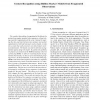Free Online Productivity Tools
i2Speak
i2Symbol
i2OCR
iTex2Img
iWeb2Print
iWeb2Shot
i2Type
iPdf2Split
iPdf2Merge
i2Bopomofo
i2Arabic
i2Style
i2Image
i2PDF
iLatex2Rtf
Sci2ools
CVPR
2006
IEEE
2006
IEEE
Gesture Recognition using Hidden Markov Models from Fragmented Observations
We consider the problem of computing the likelihood of a gesture from regular, unaided video sequences, without relying on perfect segmentation of the scene. Instead of requiring that low-and mid-level processes produce near-perfect segmentation of relevant body parts such as hands, we take into account that such processes can only produce uncertain information. The hands can only be detected as fragmented regions along with clutter. To address this problem, we propose an extension of the HMM formalism, which we call the frag-HMM, to allow for reasoning based on fragmented observations, via the use of an intermediate grouping process. In this formulation, we do not match the fragHMM to one observation sequence, but rather to a sequence of observation sets, where each observation set is a collection of groups of fragmented observations. Based on the developed model, we show how to perform three kinds of computations. The first one is to decide on the best observation group for each fra...
Computer Vision | CVPR 2006 | Hand Gesture Dataset | Observation Sequence | Possible State Sequences | Possible States Sequences | Unaided Video Sequences |
| Added | 12 Oct 2009 |
| Updated | 12 Oct 2009 |
| Type | Conference |
| Year | 2006 |
| Where | CVPR |
| Authors | Ruiduo Yang, Sudeep Sarkar |
Comments (0)

